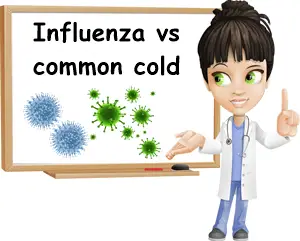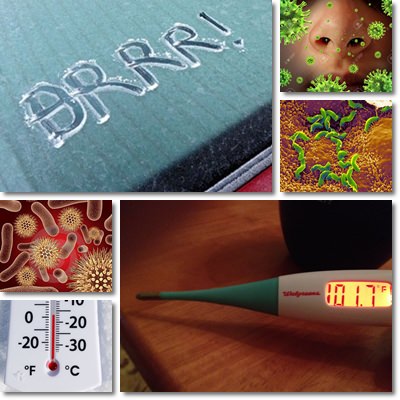You’ve had a headache all morning. You don’t feel very well and all of a sudden you sneeze. You think to yourself this is a sign you’re coming down with something. A virus maybe. As the symptoms start to unfold one by one, you’re wondering: is this a cold or the flu? This is an important question to know the answer to because one of these two respiratory infections comes with severe symptoms and even complications in some cases, whereas the other is a lot kinder. You need to know what to expect so you can be prepared. But which is it: do you have a cold or the flu?
It’s actually not always that easy to tell as you need to know which symptoms belong to which respiratory infection. Knowing the difference between the common cold and the flu also relies on knowing how quickly symptoms unfold, how long they are expected to last and what complications could arise for each of the two respiratory infections.

Once you’ve identified whether it’s a cold or the flu, you should be able to manage symptoms for quicker relief and a fast recovery. Moreover, once you know which of the two you have, you will have a better understanding of the pathogenic agent causing the infection, how it’s transmitted and how long it can survive on surfaces, reducing your risks of future infection or of transmitting it to other people.
The common cold
The common cold is a viral respiratory infection that targets primarily the upper respiratory tract: nose and throat. This is also the reason why it commonly causes a stuffy nose and sore throat, whereas the flu doesn’t. Symptoms are generally mild and unfold over the course of a few days. The infection usually lasts 7-10 days, but it can last up to 2 weeks if it’s more severe. Complications are possible, but not as common as with the flu. The only similarity between it and the flu is that they are both caused by viruses, albeit different ones. The common cold can be caused by any of over 200 viruses. The most common are rhinoviruses and coronaviruses.
1) Rhinoviruses are responsible for most common cold cases in adults and produce the most infections during fall and especially winter. Catching a cold is easiest in low temperatures when the air is dry, two ideal conditions that allow the virus to live longer outside the human body and be more infectious. There are close to 100 different types of rhinoviruses.
2) Coronaviruses are the second most common cause for the respiratory infection. This particular type of virus is also known to cause viral pneumonia or weaken the immune system to such an extent it leaves it open to secondary infections. Coronaviruses are known to produce most infections in winter and spring.
You can have more than one common cold virus at the same time. Preferred entry points are the nose and mouth, especially for rhinoviruses. This is because the nose and mouth help us breathe in air and, in doing so, the temperature inside drops resulting in a better environment for the virus. Rhinoviruses prefer temperatures of around 33 degrees Celsius for replication and they wouldn’t normally survive in the lower respiratory tract (example: lungs) where temperatures are higher, another reason why the common cold is an upper respiratory tract infection. A common cold in summer is possible, although rare. Wearing a scarf over the mouth and nose when you are in crowded places or a non-surgical face mask can help reduce infection rates by a lot. Washing hands regularly, especially before eating and avoiding touching you face constitute excellent prevention methods.
What are the symptoms of the common cold?
1) Nasal congestion causing trouble breathing through the nose.
2) Next, excess mucus production causing a runny nose.
3) Sneezing, either isolated episodes or constant sneezing.
4) Sore throat with redness, irritation, inflammation.
5) Productive cough for the most part, but can also be a dry cough.
6) Mild chest discomfort.
7) Mild aches and pains, light tiredness, malaise.
It’s also possible for a sick person to show no symptoms or only a few.

These are typical symptoms of the respiratory infection. Fever, chills, exhaustion and headaches are not common. However, not everyone will experience the same symptoms, in the same order or at the same severity. This is what makes it difficult to tell if its a cold or the flu. While there is a consensus that a cold is most contagious for the first 3-4 days, you can spread the virus for the duration of the infection. It’s really a matter of how good of an immune system you have and how quickly it is able to clear the virus (read more about The Common Cold: Causes, Symptoms and Treatment).
Influenza, or the flu
First of all, influenza and flu are the same thing. They denominate a viral respiratory infection caused by what are known as influenza viruses. Unlike the common cold, the flu tends to affect the lower respiratory tract, which explains symptoms such as severe chest discomfort. The infection should last up to two weeks if there aren’t complications, but symptoms such as cough, malaise or sore muscles may persist for 3 weeks and up to a month.
There are three classes of flu viruses: influenza A, B and C and different subtypes to each of them. Unlike the common cold which is caused by around 200 viruses, the more limited number of influenza viruses has allowed for the production of a vaccine. Usually, influenza A viruses are the most infectious and produce the most cases every year. However, during any given flu season, in addition to the predominant virus strain, there are at least two active secondary strains. This is also the reason why a lot of flu vaccines are trivalent, meaning they provide a certain level of protection against at least three different strains.
What makes the flu such a contagious and dangerous respiratory infection is the fact that flu viruses mutate continuously and at such a fast pace that each flu season is usually the result of new influenza viruses. At the same time, older strains may come back and produce outbreaks at any time. To keep up with the evolution of the virus strains, flu vaccines are updated every year depending on which strains are most common at the time. Just as interesting, different regions of the world often deal with different influenza viruses during flu season.
Just like the common cold, influenza is most contagious during the cold season. This is because flu viruses thrive at lower temperatures. Other factors such as dry air, lack of sunshine to produce vitamin D for good immunity or the overwhelming increase of time spent indoors which allows for more close contact with sick people contribute to their infectiousness. And because the cold season occurs at different times in the Northern vs the Southern hemisphere, the flu season doesn’t match either. In regions where there are not four seasons but two, like in the tropics, flu season coincides with the rainy season whose specifics favors virus transmission (read full article on Influenza: Causes, Types, Symptoms and Treatment).
While there can be severe forms to both respiratory infections, the flu is usually worse. Influenza symptoms include:
1) High fever, usually over 100.4 and up to 105.8 degrees Fahrenheit (39 to 41 degrees Celsius).
May last 3-4 days. Can alternate with chills.
2) Light sensitivity. May be a result of the fever.
3) Eyes hurt. Tired eyes (see article on Tired Eyes: Causes, Symptoms and Treatment).
4) Mild to severe aches and pain. Usually muscle aches, sore muscles like after exercising, bone pain, muscle weakness. Can last for 2-3 weeks.
5) Fatigue, exhaustion, malaise.
6) Loss of appetite, possible nausea. Especially common with children.
7) Fainting (see article on Influenza and Fainting).
8) Nasal congestion is possible, but more common with a cold.
Also, it usually does not generate excessive mucus production.
9) Dry cough and mild to severe chest discomfort are typical symptoms.
It’s possible for a sick person to be asymptomatic or present with only a few symptoms.
A high grade fever of over 104 degrees Fahrenheit (40 degrees Celsius) or a fever that doesn’t break after 3-4 days require medical attention to prevent complications. Flu vaccines are recommended as a prevention method and help build immunity against the infection over time. You can still get the flu even after you get the vaccine if the vaccine did not cover the virus strain you caught, if you have poor immunity or develop a very mild form. A lot of people who get vaccinated repeatedly over the years end up rarely having the flu or developing very mild forms due to acquired immunity.
The flu vaccine works by exposing our immune system to inactive or softer versions of certain virus strains in order to elicit a reaction from the immune system. In the case of a new strain introduced via vaccination, the immune system maps the virus and then creates antibodies for it. Should it encounter the virus in the future, it knows instantly what antibodies to make which often contributes to a faster recovery. Basically, the flu vaccine stimulates the adaptive immune system, just like a natural infection would, but it’s a more controlled process.
Both the common cold and the flu can be spread directly or indirectly. In the first case, the virus is spread by sneezing or coughing which release droplets containing it. When somebody sneezes or coughs on you, you inhale these droplets and the virus and essentially catch the cold or flu. Both respiratory infections can be transmitted indirectly, via contaminated surfaces. The virus particles from sneezes, coughing, mucus, saliva or objects and surfaces contaminated with them are active sources of infection. Touching any of these and then eating, touching your mouth, eyes or nose transmits the infection. Hard surfaces like doorknobs, cell phones, keypads, mouse, desks etc. allow the virus particles to survive for longer.
Tips for preventing colds and flu
Prevention is the same for both respiratory infections and includes:
1) Frequent hand washing, especially before eating. Wash your hands first thing when you come home.
2) Avoid contact with sick people (avoid shaking hands, hugs, eating or drinking after others, sharing personal objects).
3) Disinfect surfaces, especially doorknobs, cell phones, desks, kitchen counters, floors, towels, bed linen etc.
4) Avoid going in the house with your shoes on and change into new clothes.
5) Carry a disinfectant spray, antibacterial wipes or disinfectant alcohol with you.
Use on hands when hand washing is not possible and on door handles.
6) Keep nails short and avoid touching your face, especially nose, eyes and mouth.
7) Drink plenty of fluids, take vitamin C and zinc supplements, eat well (especially enough protein) and get enough sleep.
You can read more information on the best treatment for the common cold and flu in the respective articles highlighted above.
